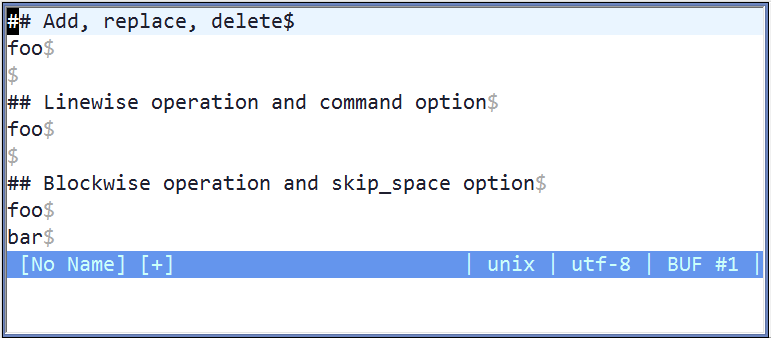sandwich.vim is a set of operator and textobject plugins to add/delete/replace surroundings of a sandwiched textobject, like (foo), "bar".
Press sa{motion/textobject}{addition}.
For example, a key sequence saiw( makes foo to (foo).
Press sdb or sd{deletion}.
For example, key sequences sdb or sd( makes (foo) to foo.
sdb searches a set of surrounding automatically.
Press srb{addition} or sr{deletion}{addition}.
For example, key sequences srb" or sr(" makes (foo) to "foo".
That's all. Now you already know enough about sandwich.vim. If you are using vim-surround, you can use a preset keymappings similar as it. See here
sandwich.vim has some functional input for {addition}/{deletion}. Check here!
This plugin provides functions to add/delete/replace surroundings of a sandwiched text. These functions are implemented genuinely by utilizing operator/textobject framework. Thus their action can be repeated by . command without any dependency. It consists of two parts, operator-sandwich and textobj-sandwich.
A sandwiched text could be resolved into two parts, {surrounding} and {surrounded text}.
-
Add surroundings: mapped to the key sequence
sa- {surrounded text} ---> {surrounding}{surrounded text}{surrounding}
-
Delete surroundings: mapped to the key sequence
sd- {surrounding}{surrounded text}{surrounding} ---> {surrounded text}
-
Replace surroundings: mapped to the key sequence
sr- {surrounding}{surrounded text}{surrounding} ---> {new surrounding}{surrounded text}{new surrounding}
- Search and select a sandwiched text automatically: mapped to the key sequence
ibandab - Search and select a sandwiched text with query: mapped to the key sequence
isandas
ib and is selects {surrounded text}. ab and as selects {surrounded text} including {surrounding}s.
|<----ib,is---->|
{surrounding}{surrounded text}{surrounding}
|<-----------------ab,as----------------->|
The point is that it would be nice to be shared the definitions of {surrounding}s pairs in all kinds of operations. User can freely add new settings to extend the functionality. If g:sandwich#recipes was defined, this plugin works with the settings inside. As a first step, it would be better to copy the default settings in g:sandwich#default_recipes.
let g:sandwich#recipes = deepcopy(g:sandwich#default_recipes)Each setting, it is called recipe, is a set of a definition of {surrounding}s pair and options. The key named buns is used for the definition of {surrounding}.
let g:sandwich#recipes += [{'buns': [{surrounding}, {surrounding}], 'option-name1': {value1}, 'option-name2': {value2} ...}]
For example: {'buns': ['(', ')']}
foo ---> (foo)
Or there is a different way, use external textobjects to define {surrounding}s from the difference of two textobjects.
let g:sandwich#recipes += [{'external': [{textobj-i}, {textobj-a}], 'option-name1': {value1}, 'option-name2': {value} ...}]
For example: {'external': ['it', 'at']}
<title>foo</title> ---> foo
As for the default operators, the possible key input in normal mode is like this.
[count1]{operator}[count2]{textobject}
Default operators do not distinguish [count1] and [count2] but operator-sandwich does. [count1] is given for {operators} and [count2] is given for {textobject}.
Operator-sandwich works linewise with the linewise-visual selection and linewise motions.
" press Vsa(
foo ---> (
foo
)Using command option, user can execute vim Ex-commands after an action. For example it can be used to adjust indent automatically.
let g:sandwich#recipes += [
\ {
\ 'buns' : ['{', '}'],
\ 'motionwise' : ['line'],
\ 'kind' : ['add'],
\ 'linewise' : 1,
\ 'command' : ["'[+1,']-1normal! >>"],
\ },
\ {
\ 'buns' : ['{', '}'],
\ 'motionwise' : ['line'],
\ 'kind' : ['delete'],
\ 'linewise' : 1,
\ 'command' : ["'[,']normal! <<"],
\ }
\ ]
" press Vsa{
foo ---> {
foo
}
" press V2jsd
{ ---> foo
foo
}Operator-sandwich also can work blockwise with the blockwise-visual selection and blockwise motions.
" press <C-v>2j2lsa(
foo (foo)
bar ---> (bar)
baz (baz)There is an option to skip white space skip_space, it is valid in default. Empty line is ignored.
" press <C-v>3j$sa(
fooooooo (fooooooo)
baaaar ---> (baaaar)
baaaz (baaaz)The option expr enables to evaluate surroundings (buns) before adding/deleting/replacing surroundings. The following recipe is an simple example to wrap texts by html style tags.
let g:sandwich#recipes += [
\ {
\ 'buns' : ['TagInput(1)', 'TagInput(0)'],
\ 'expr' : 1,
\ 'filetype': ['html'],
\ 'kind' : ['add', 'replace'],
\ 'action' : ['add'],
\ 'input' : ['t'],
\ },
\ ]
function! TagInput(is_head) abort
if a:is_head
let s:TagLast = input('Tag: ')
if s:TagLast !=# ''
let tag = printf('<%s>', s:TagLast)
else
throw 'OperatorSandwichCancel'
endif
else
let tag = printf('</%s>', matchstr(s:TagLast, '^\a[^[:blank:]>/]*'))
endif
return tag
endfunctionThe option regex is to regard surroundings (buns) as regular expressions to match and delete/replace. The following recipe is an simple example to delete both ends of html tag.
let g:sandwich#recipes += [
\ {
\ 'buns' : ['<\a[^[:blank:]>/]*.\{-}>',
\ '</\a[^[:blank:]>/]*>'],
\ 'regex' : 1,
\ 'filetype': ['html'],
\ 'nesting' : 1,
\ 'input' : ['t'],
\ },
\ ]However the above example is not so accurate. Instead of the example, there are excellent built-in textobjects it and at, these external textobjects also can be utilized through external.
let g:sandwich#recipes += [
\ {
\ 'external': ['it', 'at'],
\ 'noremap' : 1,
\ 'filetype': ['html'],
\ 'input' : ['t'],
\ },
\ ]